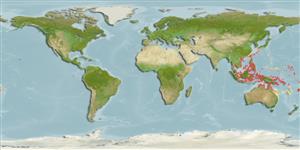Teleostei (teleosts) >
Gobiiformes (Gobies) >
Gobiidae (Gobies) > Gobiinae
Etymology: Cryptocentrus: Greek, kryptos = hidden + Greek, kentron = sting (Ref. 45335).
Eponymy: Maude de Schauensee was the daughter of ornithologist Rodolphe Meyer de Schauensee (q. [...] (Ref. 128868), visit book page.
More on author: Fowler.
Environment: milieu / climate zone / depth range / distribution range
Ecology
Marine; brackish; reef-associated; depth range 0 - 10 m (Ref. 90102). Tropical
Western Central Pacific.
Size / Weight / Age
Maturity: Lm ? range ? - ? cm
Max length : 10.0 cm SL male/unsexed; (Ref. 48637)
Dorsal spines (total): 6 - 7; Dorsal soft rays (total): 9 - 11; Anal spines: 1; Anal soft rays: 9 - 10. C. maudae differs from C. leucostictus by having a narrow white bar in the middle of each interspace between the white saddles (Ref. 37816); characterized by mottled dark brown body color; presence of at least five whitish saddles across back; snout and jaw tips bright white; anal fin with diagonal dark bands; anal fin positioned posteriorly, origin level with third ray of second dorsal fin; united pelvic fins, presence of frenum; longitudinal scale series 120; head without scales; greatest depth of body 5.9-7.0 in SL; rounded caudal fin, slightly longer than head (Ref. 90102).
Inhabits tide pools and mud flats of brackish to fresh waters (Ref. 37816). Also found on rubble patches on coastal reef (Ref. 48637).
Life cycle and mating behavior
Maturity | Reproduction | Spawning | Eggs | Fecundity | Larvae
McAllister, D.E., 1990. A working list of fishes of the world. Copies available from D.E. McAllister, Canadian Museum of Nature, P.O. Box 3443, Ottawa, Ontario K1P 6P4, Canada. 2661 p. plus 1270 p. Index. (Ref. 27116)
IUCN Red List Status (Ref. 130435: Version 2024-2)
Threat to humans
Harmless
Human uses
Tools
Special reports
Download XML
Internet sources
Estimates based on models
Preferred temperature (Ref.
123201): 26.3 - 29.3, mean 28.8 °C (based on 1972 cells).
Phylogenetic diversity index (Ref.
82804): PD
50 = 0.5000 [Uniqueness, from 0.5 = low to 2.0 = high].
Bayesian length-weight: a=0.00724 (0.00339 - 0.01546), b=3.10 (2.92 - 3.28), in cm total length, based on LWR estimates for this (Sub)family-body shape (Ref.
93245).
Trophic level (Ref.
69278): 3.4 ±0.4 se; based on size and trophs of closest relatives
Resilience (Ref.
120179): High, minimum population doubling time less than 15 months (Preliminary K or Fecundity.).
Fishing Vulnerability (Ref.
59153): Low vulnerability (10 of 100).
